|
SNAP Library 4.1, Developer Reference
2018-07-26 16:30:42
SNAP, a general purpose, high performance system for analysis and manipulation of large networks
|
|
SNAP Library 4.1, Developer Reference
2018-07-26 16:30:42
SNAP, a general purpose, high performance system for analysis and manipulation of large networks
|

Go to the source code of this file.
Functions | |
| void | LearnVocab (TVVec< TInt, int64 > &WalksVV, TIntV &Vocab) |
| void | InitUnigramTable (TIntV &Vocab, TIntV &KTable, TFltV &UTable) |
| int64 | RndUnigramInt (TIntV &KTable, TFltV &UTable, TRnd &Rnd) |
| void | InitNegEmb (TIntV &Vocab, const int &Dimensions, TVVec< TFlt, int64 > &SynNeg) |
| void | InitPosEmb (TIntV &Vocab, const int &Dimensions, TRnd &Rnd, TVVec< TFlt, int64 > &SynPos) |
| void | TrainModel (TVVec< TInt, int64 > &WalksVV, const int &Dimensions, const int &WinSize, const int &Iter, const bool &Verbose, TIntV &KTable, TFltV &UTable, int64 &WordCntAll, TFltV &ExpTable, double &Alpha, int64 CurrWalk, TRnd &Rnd, TVVec< TFlt, int64 > &SynNeg, TVVec< TFlt, int64 > &SynPos) |
| void | LearnEmbeddings (TVVec< TInt, int64 > &WalksVV, const int &Dimensions, const int &WinSize, const int &Iter, const bool &Verbose, TIntFltVH &EmbeddingsHV) |
| Learns embeddings using SGD, Skip-gram with negative sampling. More... | |
Definition at line 73 of file word2vec.cpp.
References TVVec< TVal, TSizeTy >::GetXDim(), TVVec< TVal, TSizeTy >::GetYDim(), and TVec< TVal, TSizeTy >::Len().
Referenced by LearnEmbeddings().
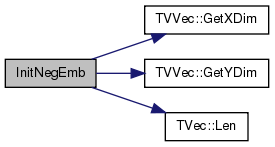

| void InitPosEmb | ( | TIntV & | Vocab, |
| const int & | Dimensions, | ||
| TRnd & | Rnd, | ||
| TVVec< TFlt, int64 > & | SynPos | ||
| ) |
Definition at line 83 of file word2vec.cpp.
References TRnd::GetUniDev(), TVVec< TVal, TSizeTy >::GetXDim(), TVVec< TVal, TSizeTy >::GetYDim(), and TVec< TVal, TSizeTy >::Len().
Referenced by LearnEmbeddings().
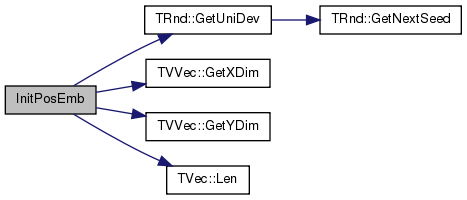

Definition at line 18 of file word2vec.cpp.
References TVec< TVal, TSizeTy >::Add(), TVec< TVal, TSizeTy >::DelLast(), TVec< TVal, TSizeTy >::Last(), TVec< TVal, TSizeTy >::Len(), and TMath::Power().
Referenced by LearnEmbeddings().
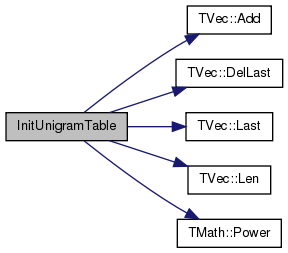

| void LearnEmbeddings | ( | TVVec< TInt, int64 > & | WalksVV, |
| const int & | Dimensions, | ||
| const int & | WinSize, | ||
| const int & | Iter, | ||
| const bool & | Verbose, | ||
| TIntFltVH & | EmbeddingsHV | ||
| ) |
Learns embeddings using SGD, Skip-gram with negative sampling.
Definition at line 160 of file word2vec.cpp.
References THash< TKey, TDat, THashFunc >::AddDat(), TMath::E, ExpTablePrecision, THash< TKey, TDat, THashFunc >::GetDat(), TVVec< TVal, TSizeTy >::GetXDim(), TVVec< TVal, TSizeTy >::GetYDim(), InitNegEmb(), InitPosEmb(), InitUnigramTable(), THash< TKey, TDat, THashFunc >::IsKey(), LearnVocab(), MaxExp, TMath::Power(), StartAlpha, TableSize, and TrainModel().
Referenced by node2vec().
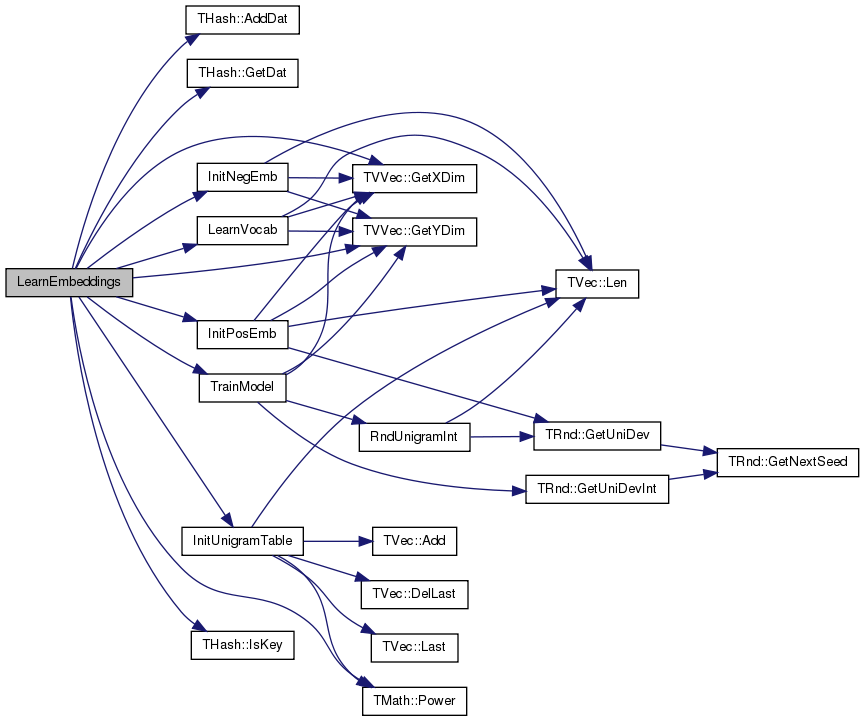

Definition at line 8 of file word2vec.cpp.
References TVVec< TVal, TSizeTy >::GetXDim(), TVVec< TVal, TSizeTy >::GetYDim(), and TVec< TVal, TSizeTy >::Len().
Referenced by LearnEmbeddings().
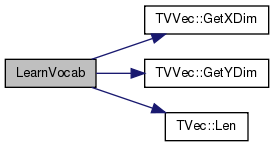

Definition at line 66 of file word2vec.cpp.
References TRnd::GetUniDev(), and TVec< TVal, TSizeTy >::Len().
Referenced by TrainModel().


| void TrainModel | ( | TVVec< TInt, int64 > & | WalksVV, |
| const int & | Dimensions, | ||
| const int & | WinSize, | ||
| const int & | Iter, | ||
| const bool & | Verbose, | ||
| TIntV & | KTable, | ||
| TFltV & | UTable, | ||
| int64 & | WordCntAll, | ||
| TFltV & | ExpTable, | ||
| double & | Alpha, | ||
| int64 | CurrWalk, | ||
| TRnd & | Rnd, | ||
| TVVec< TFlt, int64 > & | SynNeg, | ||
| TVVec< TFlt, int64 > & | SynPos | ||
| ) |
Definition at line 92 of file word2vec.cpp.
References ExpTablePrecision, TRnd::GetUniDevInt(), TVVec< TVal, TSizeTy >::GetXDim(), TVVec< TVal, TSizeTy >::GetYDim(), MaxExp, NegSamN, RndUnigramInt(), StartAlpha, and TableSize.
Referenced by LearnEmbeddings().

